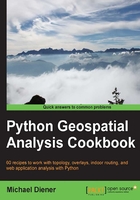
Introduction
Working with projections, in my opinion, is not too exciting but they're very important, and your ability to deal with them in any application is crucial.
The goal of this chapter is to provide some common predata screening or transformation steps to get your data in shape or, better yet, in position for geospatial analysis. We cannot always perform analysis on multiple datasets that are in different coordinate systems without the risk of achieving inconsistent results, such as data positional inaccuracies. Therefore, it is a best practice to work on data in the same coordinate system, such as EPSG:4326, when working on a global scale, or use a local coordinate system for your region that will provide you the most accurate results.
European Petroleum Survey Group or EPSG codes have decided to give all coordinate systems a number code to simplify finding and sharing projection information. Coordinate systems are described by their definitions, which are stored in text files of various formats. These text files are designed to be computer-readable formats, specifically for individual GIS desktop software packages, such as QGIS or ESRI ArcMap or for your web/scripting applications.
The EPSG code 4326 represents World Geographic System 1984 (WGS 84) and is a geographic coordinate system with longitude and latitude (x, y) units (refer to the following image). The geographic coordinate system represents the Earth as a sphere, as in this image, and the unit of measurement is degrees.

Illustration 1: Geographic Coordinate System (http://kartoweb.itc.nl/geometrics/coordinate%20systems/coordsys.html)
The second type of coordinate system is a projected coordinate system, which is a two-dimensional flat plane with constant areas, lengths, or angles that are measured on an x and y grid. EPSG:3857 Pseudo-Mercator is such a projected coordinate system where the units are in meters with correct lengths but the angles and areas are distorted. In any given projected coordinate system, only two of the three properties, area, distance, or angles, can be correctly represented on a single map. The Universal Transverse Mercator (UTM) coordinate reference system divides the world into 60 zones (refer to the following image):

Illustration 2: Projected Coordinate System UTM (http://en.wikipedia.org/wiki/Universal_Transverse_Mercator_coordinate_system#mediaviewer/File:Utm-zones.jpg)
Note
Note that you have to enter your Python virtual environment using the workon pygeoan_cb command.